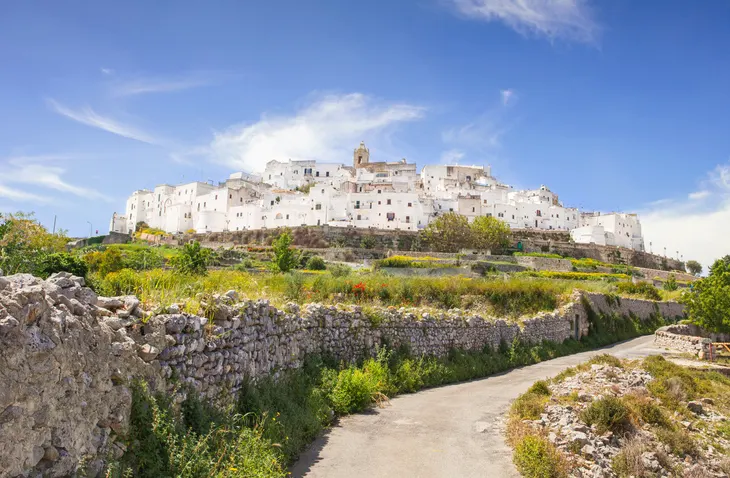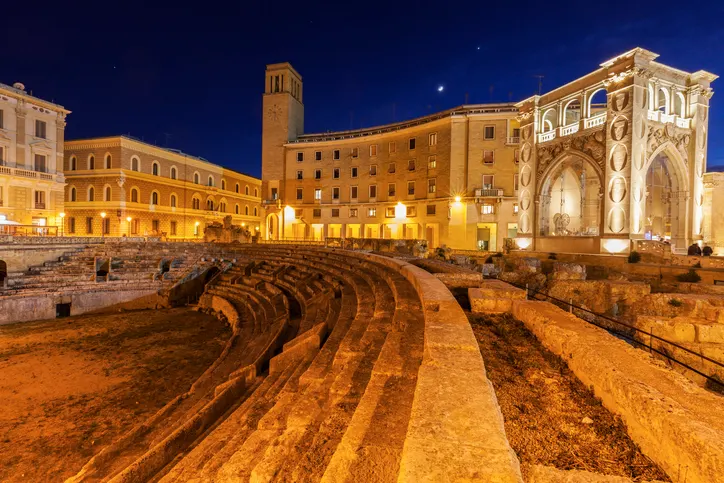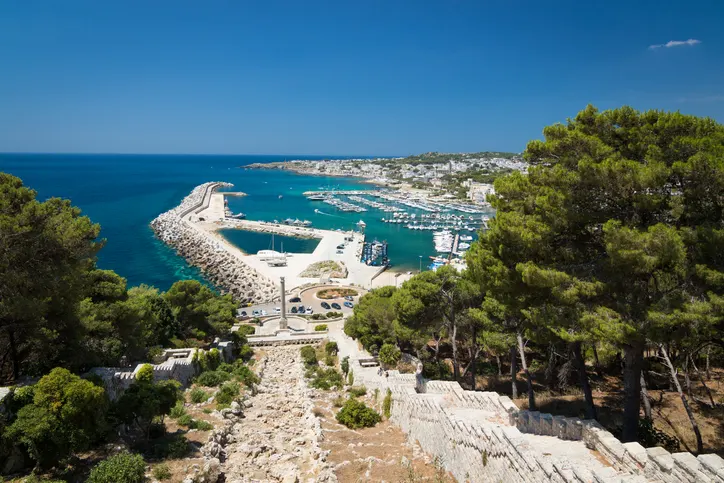Italy’s sexy stiletto heel is a peninsula skirted by the Adriatic and Ionian seas—500 miles of coastline, with a wealth of intriguing and exotic towns. There are two airports serving European gateways: Bari and Brindisi. Pick up a rental car, as it’s challenging to get around without one, especially with limited time. All the major companies are found at both airports.
Puglia presents a wealth of contrast. Sapphire waters offset intensely white towns; miles of olive trees cover the horizon, sprinkled with compacted little towns; peasant art is contained within grandiose architectural jewels, while breathtaking masterpieces are held within spare facades. This is also a land of superlatives. Many contend that it’s the Italian region with the friendliest people, the best food, and the cleanest beaches.
Get Your Free Italy Report Today!
Get Your Free Italy Report Today!
Learn more about Italy and other countries in our daily postcard e-letter. Simply enter your email address below and we’ll send you a FREE report – Italy: Europe’s Most Seductive Country.

By submitting your email address, you will receive a free subscription to IL Postcards, Overseas Dream Home, The Untourist Daily and special offers from International Living and our affiliates. You can unsubscribe at any time, and we encourage you to read more about our Privacy Policy.
The sun ripens the region’s fruits and vegetables, too. It’s a veritable hot-house of tomatoes, eggplant, peppers, figs, citrus, melons, and almonds. Vegetable-based dishes play a predominant role in Puglia’s culinary repertoire. The sea gives it a long-standing fishing tradition, too, and the seafood specialties are phenomenal. Excellent wines are produced from heritage grapes, some of them brought here millennia ago by the Greeks. Try Negroamaro or Primitivo for a robust taste of the Puglian sun.
The sun and the sea seem to infuse the towns with an energy that is radiated by the vivacity of the people; they are happy and proud, and generally eager to welcome visitors.
Day 1: Polignano a Mare

Polignano a Mare is called the Pearl of the Adriatic, and you’ll quickly see why. The whitewashed buildings look like stacked-up sugar cubes, contrasting with the azure sea. This is where Domenico Modugno wrote the song Volare. Visit his statue, whose arms are outstretched toward the town, and see how he may have been inspired by the blue sea and sky (“nel blu dipinto di blu”).
The whole centro storico is a pearl, with gleaming smooth limestone streets wending among whitewashed buildings and opening onto unexpected to sea views. Artisan shops and cafés are scattered among the lanes, so stop and refuel with a beverage and snack. A handy spot is Millennium Café at Piazza Giuseppe Verdi, with drinks, sweets, and ice cream. Especially satisfying are the crunchy almond cups filled with creamy gelato.
Stand on the bridge that hangs over the cove to get the best view of the town, sitting on its cliffs. There are diving competitions here, and sometimes unplanned practice sessions that may give you an unexpected show. If you’re ready for lunch, there’s a trattoria inside the walls of the centro storico, on via Mulini, called Osteria dei Mulini. It serves fresh fish in myriad ways, plus a few other Puglia specialties, like orecchiette pasta with rapini greens.
If you have the time, you may want to stay a couple of days here. The best beaches are to the north of Polignano a Mare. The whimsical B&B Versomare is eclectic and economical and right on Piazza Garibaldi. The swanky Suite 10 offers designer rooms and a high-tech spa.
Days 2, 3, and 4: Ostuni and the Valle D’Itria

Now it’s time to head into the low hills of the Valle d’Itria, an inland swath about 45 minutes from Polignano, with intriguing towns that have attracted a good number of expats. This is a tranquil realm of gnarled olive trees and vineyards, of little gardens that produce green-leaf crops even in the deepest winter.
Unlike in central Italy, where towns glow in shades of rich earth colors, little settlements here gleam white, shimmering on low hills under a deep blue sky. The landscape is speckled with trulli, peculiar homes with conical roofs unique to this area. You’ll see them everywhere, but especially around Alberobello.
Ostuni is a great home base, and the town that has the most expats, but Locorotondo is another good spot to stay. If you’re seriously considering Puglia, you may want to park here for several days to scout out all the towns in this section; each has its charms.
If you decide to stay in the smaller, circular Locorotondo, a super lodging choice is the Albergo Diffuso Sotto Le Cummerse. The suites are finely renovated homes scattered throughout the old town and are very comfortable. In Ostuni, you’ll find plenty of B&Bs, like B&B Casa d’Autore and Casa Baldassarre. A chic hotel at the summit of the city, Relais La Sommità, provides 5-star service, with rates starting at €250. There are plenty of choices here.
Ostuni is called the White City for obvious reasons. The old town spirals around the hill, with delightful cafés and restaurants squeezed in among the lanes. Some bars have pillows tossed on the steps of the “streets” and tables in any outdoor space wide enough. Streets spread out from the old town, with a more level district and the periphery of newer development.
Grab one of the adorable Ape (pronounced “AH-pay”) guides for a spin around town—these are tuk-tuk-like vehicles; the drivers give informative tours, and it’s just plain fun. There’s a good vibe around Ostuni, and plenty of interesting shops, and great dining options.
Sit at one of the cafés that rim the Piazza della Libertà for an aperitivo or cappuccino, and you’re bound to hear English speakers around you. It’s an easy way to connect with other expats here. Osteria Monacelle is easy to find, just off Via Cattedrale, and gives a good sampling of Puglia’s fare—hand-formed pasta with various vegetable sauces, grilled or roasted meats, and some fish, too. The antipasto is a meal by itself. Look for the cute wine truck that proffers local vintages from its tricked-out Ape-mobile.
It’s easy to see why expats love Ostuni. The sea is in sight and within reach, and the town exudes an exotic antique atmosphere. There’s plenty going on around town, too. To look at homes in the city and surrounding area, you’ll find real estate offices as you wander. The agency Gente di Mare or House Puglia is a good place to start.
Locorotondo is user-friendly and attractive, and known for its wine, so a visit to one of the area’s wineries wouldn’t be a bad idea. Its well-kept historic center is really attractive, and Taverna del Duca is the place to sit outside on the street and pack yourself with pasta or savor the meat dishes, like lamb or chicken with peppers.
Spend some time getting a feel for the towns of the Valle d’Itria. It would take a week to see all of them, but definitely check out Martina Franca, the largest town of the Valle d’Itria, and the most elegant. Its buildings are adorned with baroque flourishes and stately wrought iron balconies. Its graceful curving piazza is one of the prettiest in Puglia, and the regal Ducal Palace houses the town hall, where frescoed salons host cultural events throughout the year, and concerts take place in the courtyard. If you have a day or two to spare, you could do worse than spend them here.
Another town of interest is Cisternino, which along with Locorotondo is listed by the borghi piu’ belli d’Italia asamong “the most beautiful small towns in Italy.” (The borghi piu’ belli d’Italia is an organization launched by the National Tourism Association of Italian Towns, which awards the designation based on certain criteria.) Cisternino also possesses a coveted Orange Flag, a designation of excellence, from the Touring Club Italiano. Here you’ll find another circular white-washed town with a tidy center and affordable homes, both in town and in the surrounding countryside.
One thing you must do in Cisternino or Martina Franca is sink your teeth into the grilled meats at a butcher shop-grill. Called bracerie (or fornelli in Cisternino), these are regular butcher shops that also grill the meats you select on the spot. A specialty here is a skewer of bite-sized stuffed meat nuggets, bombette. These shop-grills are usually open in the evening time.
Ceglie Messapica blends Greek, Moorish, and Puglian styles among its white and sand-colored streets. Less known than the other towns in the area, it also has some of the lower real estate prices. Martina Franca-based real estate company Immobiliare Valle d’Itria can assist you in your search.
You can’t leave the Valle d’Itria without stopping in Alberobello. It is the epicenter of those gnome-like homes called trulli—the entire town is constructed of them and it’s quite a sight to see. You can sleep in a trullo, if you wish. There are loads of B&Bs and hotels that let you spend a night or more under those pointy roofs.
Get Your Free Italy Report Today!
Get Your Free Italy Report Today!
Learn more about Italy and other countries in our daily postcard e-letter. Simply enter your email address below and we’ll send you a FREE report – Italy: Europe’s Most Seductive Country.

By submitting your email address, you will receive a free subscription to IL Postcards, Overseas Dream Home, The Untourist Daily and special offers from International Living and our affiliates. You can unsubscribe at any time, and we encourage you to read more about our Privacy Policy.
Days 5 and 6: Lecce and Otranto

Now you’re going to go deeper south, into the area of Puglia known as the Salento. Known for their exuberance, the people here love their festivals and go over the top in celebrating every holiday, patron saint day, and local food specialty. Breathtaking art is hidden in even the smallest of towns, and the beaches are some of the best in Puglia (and celebrated among the best in Italy).
Your destination is Lecce, the grand dame of Puglia. All dolled up in baroque embellishments, it’s impossible not to love Lecce. The buildings of the city are built in local limestone, lathered with joyous ornate carvings and adornments done with such exuberance that it gives the city a sense of gaiety. Lecce is extravagant, even flamboyant. It is the cultural capital of Puglia, with so many monuments, churches, palaces, and museums that it has been given the nickname, “The Florence of the South.”
You’ll find a vast selection of lodgings in the city center. The Patria Palace is in the Santa Croce area, in an old palazzo with nice-sized rooms and an upper terrace for views, very upscale with prices to match. Dimora San Biagio is a lovely B&B if you're looking for a more affordable rate.
Around town, the streets are packed with monuments, museums, and art-filled churches, but even just the exteriors are gorgeous.
If you’re ready for lunch, grab a delicious bite at the informal Dall’Antiquario in Via Maremonti, a tiny place with home-style food. You won’t go hungry anywhere in Lecce. The streets are generously sprinkled with eateries and wine bars. For something special, Le Quattro Spezierie is a rooftop restaurant at the Risorgimento Resort Hotel. Do some shopping on Via Vittorio Emanuele and Via Palmieri. The Roman theater, the cathedral, and the medieval castle are just a few of the things to see here.
If you want to look at homes, Coldwell Banker and Tecnorete (tel. +39 083-209-0219) are good choices to start with.
Continue to enjoy Lecce and get a feel for the city. Take a half-day or so to visit Otranto, a delightful seaside town just 40 minutes to the south. With its historic castle, adorable old town, and colorful marina, Otranto is a sunny spot and has some great beaches right in town. There’s a larger, newer town surrounding the old town settlement, but it all radiates active life.
If you have time, drive further inland to gallant Galatina, a captivating “mini-Lecce” for those seeking a smaller city without sacrificing style. With 27,000 residents, it is still an active place, with a gorgeous atmosphere, and surprisingly unknown. Be sure to go inside the church of Santa Caterina for a big surprise—every surface is frescoed.
Day 7: The Last Day in Puglia

It will be hard to part with Puglia; the place seems to put everyone under its spell. If you have enough time to spend your last day exploring, it’s fun to drive to the very tip of the peninsula, at Santa Maria di Leuca, the southernmost point of Italy’s heel. Here, you’re closer to Greece and Albania than you are to Ostuni. Drive back up along the Ionian Sea, stopping in Gallipoli, where you’ll cross a bridge to reach the “island” old town.
Head back to the airport in Bari or Brindisi for your flight, or drive on to your next destination.
Get Your Free Italy Report Today!
Get Your Free Italy Report Today!
Learn more about Italy and other countries in our daily postcard e-letter. Simply enter your email address below and we’ll send you a FREE report – Italy: Europe’s Most Seductive Country.

By submitting your email address, you will receive a free subscription to IL Postcards, Overseas Dream Home, The Untourist Daily and special offers from International Living and our affiliates. You can unsubscribe at any time, and we encourage you to read more about our Privacy Policy.
